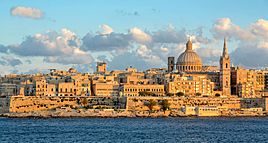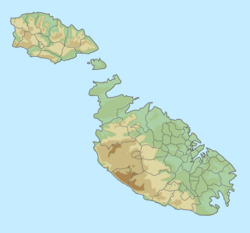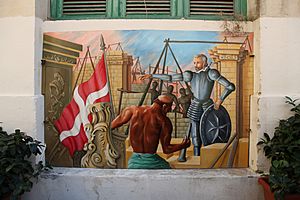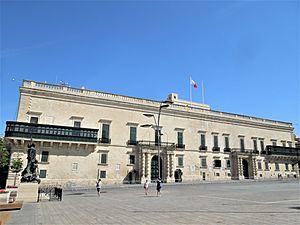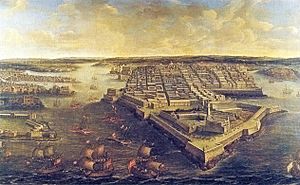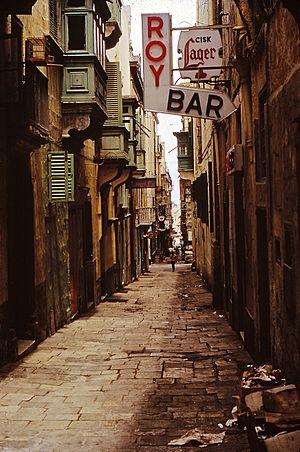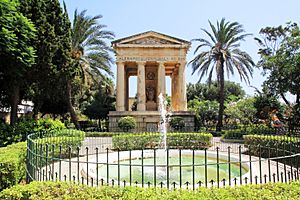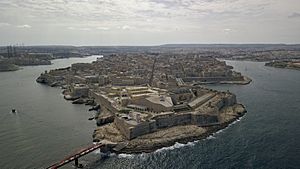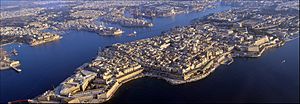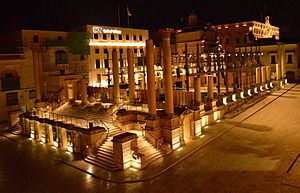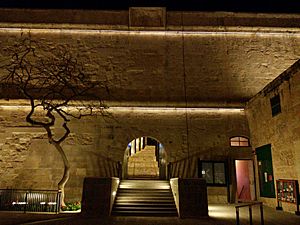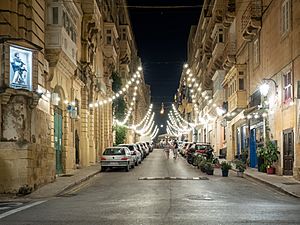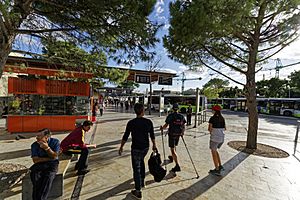Valletta facts for kids
Quick facts for kids
Valletta
Il-Belt Valletta (Maltese)
|
|||||||||||||||
|---|---|---|---|---|---|---|---|---|---|---|---|---|---|---|---|
|
Capital city and local council
|
|||||||||||||||
|
From top: Skyline, Saluting Battery, Lower Barrakka Gardens, St. John's Co-Cathedral and the city walls
|
|||||||||||||||
|
|||||||||||||||
| Nickname(s):
Il-Belt
|
|||||||||||||||
| Motto(s):
City Built By Gentlemen For Gentlemen
|
|||||||||||||||
| Country | Malta | ||||||||||||||
| Region | Port Region | ||||||||||||||
| District | Southern Harbour District | ||||||||||||||
| Capital city | 18 March 1571 | ||||||||||||||
| Founded by | Jean de Parisot Valette | ||||||||||||||
| Borders | Floriana | ||||||||||||||
| Area | |||||||||||||||
| • Capital city and local council | 0.61 km2 (0.24 sq mi) | ||||||||||||||
| • Urban | 256 km2 (99 sq mi) | ||||||||||||||
| Elevation | 56 m (184 ft) | ||||||||||||||
| Population
(Jan. 2019)
|
|||||||||||||||
| • Capital city and local council | 5,157 | ||||||||||||||
| • Density | 8,450/km2 (21,900/sq mi) | ||||||||||||||
| • Urban | 480,134 | ||||||||||||||
| Demonym(s) | Belti (m), Beltija (f), Beltin (pl) | ||||||||||||||
| Time zone | UTC+1 (CET) | ||||||||||||||
| • Summer (DST) | UTC+2 (CEST) | ||||||||||||||
| Postal code |
VLT
|
||||||||||||||
| Dialing code | 356 | ||||||||||||||
| ISO 3166 code | MT-60 | ||||||||||||||
| Patron saints | St. Dominic Our Lady of Mount Carmel St. Paul St. Augustine |
||||||||||||||
| Day of festa | 3 August 10 February |
||||||||||||||
|
|||||||||||||||
Valletta (pronounced va-LET-ta) is the capital city of Malta. It is one of Malta's 68 local council areas. The city is located between two large harbours: the Grand Harbour to the east and Marsamxett Harbour to the west. In 2021, about 5,157 people lived there.
As Malta's capital, Valletta is a busy place for shopping, restaurants, and cafes. It is the southernmost capital city in Europe. It is also the smallest capital city in the European Union, covering only about 0.61 square kilometres (0.24 sq mi).
Valletta's buildings were built in the 1500s by the Knights Hospitaller. The city was named after Jean Parisot de Valette. He was a French leader who successfully defended Malta from an invasion. The city mostly features Baroque architecture. It also has elements of other styles like Mannerist and Neo-Classical. Sadly, the Second World War caused a lot of damage, especially destroying the Royal Opera House.
In 1980, UNESCO officially recognized Valletta as a World Heritage Site. The city has 320 historic monuments in a small area of 0.55 square kilometers (0.21 sq mi). This makes it one of the most concentrated historic places in the world. Valletta is sometimes called an "open-air museum." It was chosen as the European Capital of Culture in 2018. In 2016, Valletta was also named the sunniest city in Europe.
The city is famous for its strong fortifications. These include bastions, curtains, and cavaliers. It is also known for its beautiful Baroque palaces, gardens, and churches.
Contents
History of Valletta
The land where Valletta now stands was once called Xagħret Mewwija. This name means "sheltered place." Some people believe the very end of the land was called Xebb ir-Ras. This name came from a lighthouse that was once there. A family named Sceberras owned land in this area. Eventually, the whole piece of land became known as Sceberras.
![]() Hospitaller Malta (1566–1798)
Hospitaller Malta (1566–1798)
![]() French Republic (1798–1800)
French Republic (1798–1800)
![]() Protectorate of Malta (1800–1813)
Protectorate of Malta (1800–1813)
![]() Crown Colony of Malta (1813–1964)
Crown Colony of Malta (1813–1964)
![]() State of Malta (1964–1974)
State of Malta (1964–1974)
![]() Republic of Malta (1974–present)
Republic of Malta (1974–present)
New studies show that the name "Xeberras" is very old. It comes from a language called Punic. It means 'the headland' or 'the middle peninsula'. This describes the land perfectly.
Building the City with the Knights
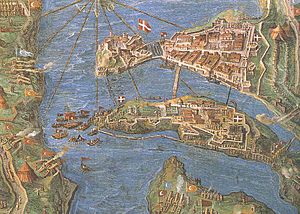
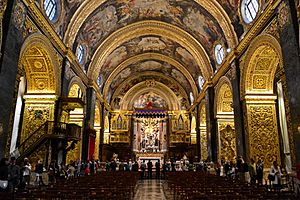
The Order of Saint John first thought about building a city here in 1524. At that time, there was only a small watchtower on the peninsula. It was called Saint Elmo. In 1552, this old tower was taken down. A bigger fort, Fort Saint Elmo, was built in its place.
In 1565, the Great Siege of Malta happened. The Ottomans attacked Malta. Fort Saint Elmo fell to the Ottomans. But the Knights, with help from Sicily, eventually won the siege. After this victory, the leader, Grand Master Jean Parisot de Valette, decided to build a new strong city. This city would protect the Knights in Malta. It was named La Valletta after him.
Grand Master de Valette asked European kings for help. Many offered support because the Knights were famous after their victory. Pope Pius V sent his military architect, Francesco Laparelli, to design the new city. Philip II of Spain sent a lot of money. The first stone of the city was laid on March 28, 1566. It was placed in what became Our Lady of Victories Church.
An old Maltese saying from that time was: "There will come a time when every piece of land on Sciberras Hill will be worth its weight in gold." This showed how important people thought the new city would be.
De Valette died in 1568 and never saw the city finished. He is buried in St. John's Co-Cathedral.
Francesco Laparelli designed the city. He made a new plan, different from old Maltese towns. Those towns had narrow, winding streets. Laparelli designed Valletta with straight, wide streets in a grid plan. The main streets started at the City Gate. They ended at Fort Saint Elmo, which was rebuilt. Some city walls were built 47 metres (154 ft) high. Laparelli's assistant was Girolamo Cassar. Cassar took over building the city after Laparelli died in 1570.
The city of Valletta was mostly finished by the early 1570s. It became the capital on March 18, 1571. Grand Master Pierre de Monte moved his home to the Grandmaster's Palace in Valletta.
Seven large buildings, called Auberges, were built for the different groups of Knights. These were finished by the 1580s. An eighth Auberge, Auberge de Bavière, was added later.
More walls, called the Floriana Lines, were built to protect Valletta. These were named after the architect, Pietro Paolo Floriani. Over time, a town grew between Valletta's walls and the Floriana Lines. This town became Floriana.
In 1634, a gunpowder factory exploded in Valletta. It killed 22 people. In 1749, some slaves planned to take over Valletta. But their plan was discovered, and the revolt was stopped. Later, Grandmaster Pinto made the city even more beautiful. Many important buildings, like Auberge de Castille, were rebuilt in the new Baroque style.
In 1775, a small revolt happened. Rebels captured Fort Saint Elmo and Saint James Cavalier. But the revolt was quickly put down.
French and British Rule
In 1798, the French army invaded Malta. They forced the Knights to leave. The Maltese people rebelled against the French. French troops stayed in Valletta until they surrendered to the British in September 1800. In the early 1800s, the British thought about tearing down most of Valletta's walls. This idea came up again later, but the walls were never destroyed. They are still mostly standing today.
Building projects continued under British rule. Gates were made wider, and some buildings were rebuilt. The Malta Railway opened in 1883. It connected Valletta to Mdina. The railway closed in 1931 when buses became more popular.
In 1939, Valletta stopped being the main base for the British Royal Navy. This was because it was too close to Italy. During the Second World War, Valletta became a target. German and Italian air raids caused a lot of damage. The Royal Opera House was destroyed in these attacks.
Valletta Today
In 1980, Valletta hosted the 24th Chess Olympiad.
The entire city of Valletta has been a World Heritage Site since 1980. This means it is a special place protected by UNESCO. On November 11, 2015, Valletta hosted the Valletta Summit on Migration. European and African leaders talked about the European migrant crisis. Later that month, the city also hosted part of the Commonwealth Heads of Government Meeting 2015.
Valletta was the European Capital of Culture in 2018.
City Life and Buildings
Valletta's buildings show different styles, from 1500s Baroque to modern designs. The city is Malta's main cultural center. It has many unique churches, palaces, and museums. These are popular places for visitors. In 1830, Benjamin Disraeli, who later became British Prime Minister, visited Valletta. He called it "a city of palaces built by gentlemen for gentlemen." He said Valletta's architecture was as good as, or better than, any capital in Europe.
Important historic buildings include:
- St John's Co-Cathedral: This was once the main church for the Knights of Malta. It has the only signed painting by the famous artist Caravaggio.
- Auberge de Castille et Leon: This was the official home for the Knights from Castille, Léon, and Portugal. Today, it is the office of the Prime Minister of Malta.
- Grandmaster's Palace: Built between 1571 and 1574, this was where the Grand Master of the Knights lived. It used to house the Maltese Parliament. Now, it is the office of the President of Malta. The Parliament is now in a new building at the city entrance.
Admiralty House is a Baroque palace from the late 1570s. It was the home of the British Navy's Commander-in-Chief in the Mediterranean. From 1974 to 2016, it was the National Museum of Fine Arts.
The Manoel Theatre (Teatru Manoel) was built very quickly in 1731. It is one of the oldest working theaters in Europe. The Mediterranean Conference Centre was once the Sacra Infermeria. Built in 1574, it was one of Europe's most famous hospitals during the Renaissance. The city's strong walls, built by the Knights, are about 100 metres (330 ft) high. They add to the city's unique look.
Valletta's Neighbourhoods
Valletta has several unofficial neighbourhoods:
- Strada Rjali – This is the main street, called Triq ir-Repubblika.
- l-Arċipierku – An area near the Sacra Infermeria. It might be named after "archipelago" because its lanes make it look like many "islands" of houses.
- il-Baviera – An area around the English Curtain, near Auberge de Bavière.
- il-Biċċerija – An area named after a slaughterhouse that used to be there.
- il-Kamrata – Another area near the Sacra Infermeria. It is named after a spiritual retreat that was replaced by housing.
- il-Fossa – An area near Fort Saint Elmo. It is known as the least maintained part of Valletta.
- Manderaggio (il-Mandraġġ) – This area was meant to be a small harbour but was never finished. A poor area grew there instead. These old buildings were taken down in the 1950s and replaced with new homes.
Economy and Jobs
In 2015, about 91,000 people worked in the greater Valletta area. This is almost half of all jobs in Malta. Like the rest of Malta, tourism is a very important part of the economy. The area around the Grand Harbour is a major tourist spot. For cruise ships, the Valletta Waterfront Project was started in 2002. This project built a cruise terminal in the Grand Harbour.
Valletta also has a publishing company, Allied Newspapers Ltd. This company publishes two leading newspapers: Times of Malta and The Sunday Times of Malta.
Education in Valletta
The Valletta Campus of the University of Malta is in the Old University Building. It offers international master's programs.
There is also a church school in Valletta called "St. Albert the Great."
Culture and Arts
Valletta was the European Capital of Culture in 2018. The year began with a big event called Erba' Pjazez (Four Squares). Shows were held in four main squares: Triton Square, St. George's Square, St. John's Square, and Castille Square. There were also other shows around the city. This was followed by an art display called Kif Jgħid il-Malti (Maltese Sayings). It featured Maltese proverbs made from gypsum to celebrate the language.
Saint James Cavalier
Saint James Cavalier was originally a platform for cannons. In 2000, it was turned into a Centre of Creativity. It now has a small theatre, a cinema, music rooms, and art galleries. Many exhibitions are held there regularly. Over a million people have visited it since it opened.
Music Scene
The Valletta International Baroque Festival takes place every January. Jazz music became popular in Malta on Strait Street. Sailors from Allied countries visited this area during the World Wars. Malta's Jazz Festival used to be held here. Strait Street is also known as The Gut. This area is now being improved. The city has two main band clubs: the "King's Own Band Club" and the "La Valette National Philharmonic Society."
Carnival Fun
Valletta is where the Maltese Carnival is held every February. This happens before Lent. In 2020 and 2021, there were no carnival floats because of the Covid-19 pandemic. But the floats returned in 2022.
Sadly, in 1823, a crowd crush happened during the Valletta carnival. At least 110 boys died.
Religious Feasts
- The feast of Our Lady of Mount Carmel is celebrated on July 16.
- Saint Paul's feast is celebrated on February 10.
- Saint Dominic's feast is celebrated in Valletta on or before August 4.
- The feast of Saint Augustine is celebrated on the third Sunday after Easter.
- People in the city also have an annual procession for St. Rita.
Sister Cities
Valletta is connected with these cities around the world:
 Palermo, Italy
Palermo, Italy Pisa, Italy
Pisa, Italy Cortona, Italy (since 2022)
Cortona, Italy (since 2022) Rhodes, Greece
Rhodes, Greece Byblos, Lebanon
Byblos, Lebanon Piran, Slovenia
Piran, Slovenia
Getting Around Valletta
Malta International Airport is about 8 kilometres (5.0 mi) from Valletta, in the town of Luqa. Malta's public transport system uses buses. Most bus routes start or end in Valletta. The main bus station is just outside the city gate. Cars are restricted inside the city. Some main roads are only for people walking.
In 2006, a park and ride system was started. This helps people find parking. You can leave your car in a nearby car park in Floriana. Then, you can take a small van into the city.
In 2007, a system was put in place to charge cars for entering the city. This helps reduce traffic and encourages businesses. Cameras take pictures of cars entering and leaving the area. Car owners are charged based on how long they stay.
Valletta also has electric taxis. These taxis take people from 10 points in Valletta to any place in the city.
As of 2021, there are plans for an underground Malta Metro system. It would cost about €6.2 billion and focus on the Valletta area.
Sports in Valletta
- Valletta F.C. is the city's Association Football team and Futsal team.
- Valletta Lions RFC is the Rugby Football Union team.
- Valletta's Marsamxett Harbour has a "Regatta" (Rowing) Team. They take part in the yearly traditional Regatta on Victory Day (September 8).
- Valletta United W.P.C. is a Water Polo Club from the Marsamxett side of the city.
- Valletta V.C. is a Volleyball club.
- Marsamxett Boċċi is a Boċċi (a type of bowling game) Club from Marsamxett, Valletta.
- Valletta St. Paul's Boċċi is a Boċċi Club from the L-Arċipierku side of Valletta.
Images for kids
-
Valletta harbour around c. 1850, photo by Calvert Jones
-
Royal Opera House in 1911
-
Bomb damage in Valletta during the Second World War
-
Renzo Piano's Valletta City Gate (2014)
See also
 In Spanish: La Valeta para niños
In Spanish: La Valeta para niños


